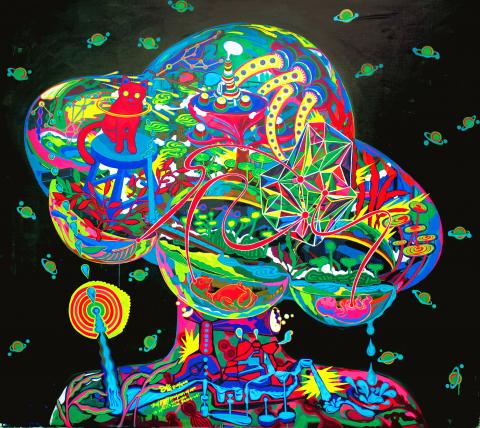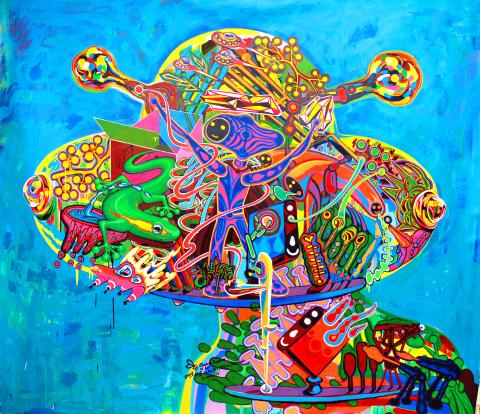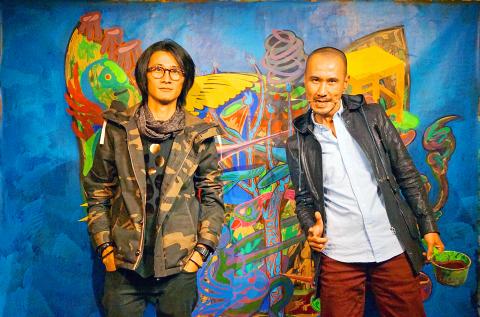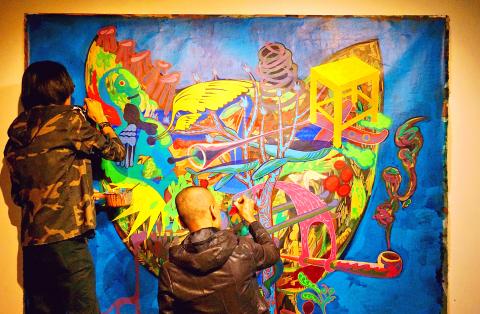Lu Mu-jen (呂沐芢) and Chiao Sheng-wei (焦聖偉) are childhood best friends and artists who are out of this world. Their collection of artwork depicting various alien, plant and animal life forms intertwined inside UFO-shaped single-celled organisms is currently on display at Frees Art Space (福利社) in Taipei’s Zhongshan District (中山).
When asked if they believe in aliens, both artists responded in the positive with blank looks on their faces which read, why is this question even being asked? Lu has never seen an alien in real life, but Chiao says he’s seen something that looked like a UFO when he was at graduate school in Greater Tainan. Despite their different experiences though, both artists steadfastly believe that life on other planets exist and use this as inspiration for their newest collection, the Euglena Program of Art.
COMMUNICATION IS KEY

Photo Courtesy of Association of the Visual Arts in Taiwan
The artists were putting the finishing touches on their latest addition to the collection, dabbing paint on their canvas in near-perfect sync as photographers snapped away and reporters scribbled in their notepads. Lu and Chiao never discuss what to paint beforehand. Their style is impromptu and organic — they simply pick up their brushes and see where the painting takes them.
“It’s like we are having a conversation with each other but with brush strokes, not words, and it’s exciting not knowing what the next brush stroke or what the end result will be” Lu said.
Communication is one of the key messages in their artwork. Within the earth itself there are numerous modes of communication, many of which are not discernible to the human eye or ear.

Photo Courtesy of Association of the Visual Arts in Taiwan
“Take dolphins for instance,” Lu said, referring to the dolphins in many of their paintings. “They are highly intelligent creatures who communicate through their sonar abilities.”
Lu and Chiao’s logic is that just because humans cannot see, hear, touch, taste or feel something does not mean that it does not exist. Naturally, this logic extends to aliens and life on other planets — perhaps other-worldly creatures use other means of communication, and they have been trying to reach out to us, but we simply cannot detect their message.
The Euglena Program of Art is essentially Lu and Chiao projecting this logic onto canvas. As Chiao says, “no one can yet prove the existence of aliens, so we feel like we have to express it through art instead.”

Photo: Dana Ter, Taipei Times
OTHER-WORLDLY BUT DOWN-TO-EARTH
From afar, the Euglena Project of Art resembles colorful UFO heads. Up close, it’s more of a mish-mash of animals, organisms and elements thrown together — dolphins that swim upstream, cats that smoke cigars and aliens that sprout eagle-like wings. And yet — maybe it’s the random smiley faces interspersed throughout almost every painting — it just seems like everything is coexisting in perfect harmony, or at least, the different elements are trying to understand each other.
“We draw such animals and aliens altogether because they are all very smart creatures,” Lu said.

Photo: Dana Ter, Taipei Times
He adds that he and Chiao both grew up loving the abundance of nature in Taiwan and watching all sorts of television shows and movies. As a result, their art has been influenced by four main tenets: aliens, nature, environmental issues and human beings like Bruce Lee (李小龍) or Michael Jackson who have changed the world in a positive way.
“Such a combination is not possible in real life, but in art, it’s possible,” Chiao says, “therefore, our paintings represent a type of hope.”
Just as there is no definitive answer to the question “do aliens exist?”, there is no definitive meaning behind Lu and Chiao’s paintings. Lu says that the paintings show how “aliens are trying to teach us peaceful messages like mutual understanding and how to preserve the environment.”
Chiao says that to him, the most important message is “a feeling of harmony.”
Likewise, each individual will have his or her own interpretation, although Lu and Chiao say that they hope their artwork will evoke happy feelings in their viewers since they were largely inspired by elements and experiences which made them happy.
So, while Lu and Chiao may seem out of this world, their desire for peaceful coexistence amongst the various elements of worldly and other-worldly life forms is rather endearing and down-to-earth.

That US assistance was a model for Taiwan’s spectacular development success was early recognized by policymakers and analysts. In a report to the US Congress for the fiscal year 1962, former President John F. Kennedy noted Taiwan’s “rapid economic growth,” was “producing a substantial net gain in living.” Kennedy had a stake in Taiwan’s achievements and the US’ official development assistance (ODA) in general: In September 1961, his entreaty to make the 1960s a “decade of development,” and an accompanying proposal for dedicated legislation to this end, had been formalized by congressional passage of the Foreign Assistance Act. Two

President William Lai’s (賴清德) March 13 national security speech marked a turning point. He signaled that the government was finally getting serious about a whole-of-society approach to defending the nation. The presidential office summarized his speech succinctly: “President Lai introduced 17 major strategies to respond to five major national security and united front threats Taiwan now faces: China’s threat to national sovereignty, its threats from infiltration and espionage activities targeting Taiwan’s military, its threats aimed at obscuring the national identity of the people of Taiwan, its threats from united front infiltration into Taiwanese society through cross-strait exchanges, and its threats from

Despite the intense sunshine, we were hardly breaking a sweat as we cruised along the flat, dedicated bike lane, well protected from the heat by a canopy of trees. The electric assist on the bikes likely made a difference, too. Far removed from the bustle and noise of the Taichung traffic, we admired the serene rural scenery, making our way over rivers, alongside rice paddies and through pear orchards. Our route for the day covered two bike paths that connect in Fengyuan District (豐原) and are best done together. The Hou-Feng Bike Path (后豐鐵馬道) runs southward from Houli District (后里) while the

March 31 to April 6 On May 13, 1950, National Taiwan University Hospital otolaryngologist Su You-peng (蘇友鵬) was summoned to the director’s office. He thought someone had complained about him practicing the violin at night, but when he entered the room, he knew something was terribly wrong. He saw several burly men who appeared to be government secret agents, and three other resident doctors: internist Hsu Chiang (許強), dermatologist Hu Pao-chen (胡寶珍) and ophthalmologist Hu Hsin-lin (胡鑫麟). They were handcuffed, herded onto two jeeps and taken to the Secrecy Bureau (保密局) for questioning. Su was still in his doctor’s robes at